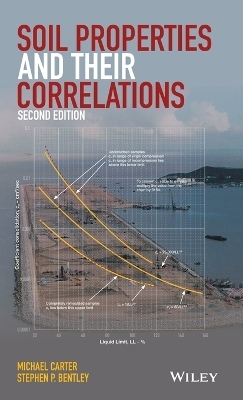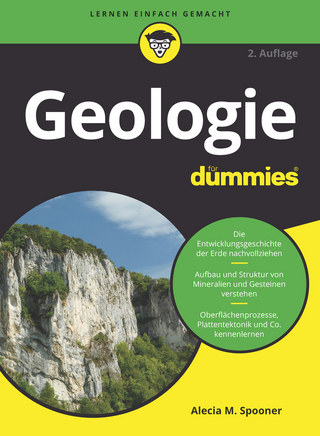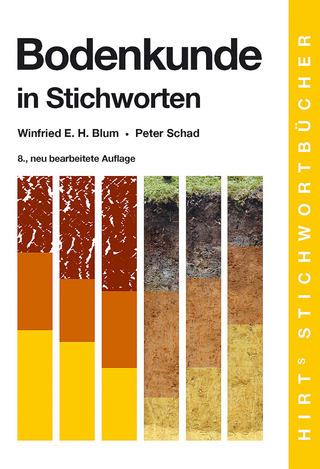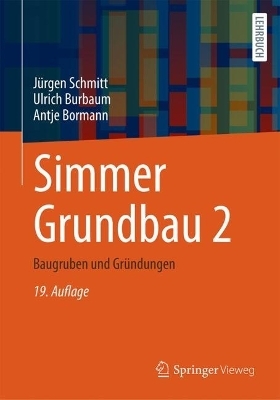
Soil Properties and their Correlations
John Wiley & Sons Inc (Verlag)
978-1-119-13087-1 (ISBN)
Soil Properties and their Correlations, Second Edition provides a summary of commonly-used soil engineering properties and gives a wide range of correlations between the various properties, presented in the context of how they will be used in geotechnical design.
The book is divided into 11 chapters: Commonly-measured properties; Grading and plasticity; Density; Permeability, Consolidation and settlement; Shear strength; California bearing ratio; Shrinkage and swelling characteristics; Frost susceptibility; Susceptibility to combustion; and Soil-structure interfaces. In addition, there are two appendices: Soil classification systems; and Sampling methods.
This new, more comprehensive, edition provides material that would be of practical assistance to those faced with the problem of having to estimate soil behaviour from little or no laboratory test data.
Key features:
Soil properties explained in practical terms.
A large number of correlations between different soil properties.
A valuable aid for assessing design values of properties.
Clear statements on practical limitations and accuracy.
An invaluable source of reference for experienced professionals working on geotechnical design, it will also give students and early-career engineers an in-depth appreciation of the appropriate use of each property and the pitfalls to avoid.
Mike Carter is a civil and geotechnical engineer whose experience ranges from the practical, including site-based supervision of construction work, to the analytical, including the preparation of geotechnical design manuals and computer-based methods for consulting engineers. He has worked both in the UK and overseas; for consulting engineers, a contractor, a specialist site investigation contractor and as a university lecturer. In terms of engineering complexity, projects he has worked on have varied from the basic, such rural roads in East Africa and India, to the large and complex, such as the construction of an artificial island for Macau International Airport. He has also been involved in the analysis and rectification of numerous earthworks failures and has worked as a lecturer and trainer in the UK, Indonesia and Sri Lanka. He is the author of three books on geotechnical engineering. Dr Bentley is an Engineering Geologist. During his long academic career at Cardiff University he has acted as a consultant to many large UK companies including the Department of the Environment (UK). He has also been retained as a consultant to the Departments of Public Works in Brunei and Saudi Arabia. He has supervised 12 PhD and over 60 MSc students; most of the PhD research topics were collaborative with industry. He has published 110 technical papers. Highlights of his research work include the first edition of the textbook 'Correlation of Soil Properties' which was adopted by many consultancy firms as a standard reference book. Also the visualisation software, 'STRATA', which was successfully commercialised and sold into over 100 companies in 12 countries worldwide.
Preface x
Acknowledgements xii
List of Symbols xiii
List of Property Values and Correlations in the Tables and Figures xx
1 Commonly Measured Properties 1
1.1 Moisture Content 2
1.1.1 Test Methods 2
1.2 Grading 3
1.2.1 Test Methods 4
1.3 Plasticity 7
1.3.1 Test Methods 7
1.4 Specific Gravity of Soil Particles 10
1.4.1 Test Method 10
1.5 Soil Density 11
1.5.1 Test Methods 12
1.6 Permeability 16
1.6.1 Test Methods 17
1.7 Consolidation 19
1.7.1 Test Method 20
1.8 Shear Strength 21
1.8.1 Test Methods 22
1.8.2 Choice of Shear Strength Test 27
1.9 Standard Compaction Test 27
1.9.1 Test Method 27
1.10 California Bearing Ratio 30
1.10.1 Test Method 30
1.11 Other Properties 32
1.11.1 Swelling Potential 32
1.11.2 Frost Susceptibility 32
1.11.3 Combustible Content 33
References 33
2 Grading and Plasticity 34
2.1 Grading 34
2.1.1 The influence of Grading on Soil Properties 35
2.1.2 Standard Grading Divisions 36
2.2 Plasticity 38
2.2.1 Consistency Limits 41
2.2.2 Development of the Liquid and Plastic Limit Tests 42
2.2.3 Plasticity Test Results and Plasticity Descriptions 43
2.2.4 The Shrinkage Limit Test 43
2.2.5 Consistency Limits as Indicators of Soil Behaviour 45
2.2.6 Limitations of the Use of Plasticity Limits 47
References 47
3 Density 49
3.1 Density in the Context of Soils 49
3.1.1 Density Relationships 50
3.1.2 Typical Natural Density Values 53
3.2 Compacted Density 53
3.2.1 Typical Compacted Density Values 54
3.2.2 Quick Estimates of Maximum Dry Density and Optimum Moisture Content 55
3.3 Relative Density 59
3.3.1 Field Measurement of Relative Density 59
3.3.2 SPT Correction Factors 60
3.3.3 Other Dynamic Cone Tests 64
3.3.4 Static Cone Tests 65
References 66
4 Permeability 68
4.1 Effects of Soil Macro]Structure 69
4.2 Typical Values 69
4.3 Permeability and Grading 71
References 73
5 Consolidation and Settlement 74
5.1 Compressibility of Clays 75
5.1.1 Compressibility Parameters 75
5.1.2 Settlement Calculations Using Consolidation Theory 78
5.1.3 Settlement Calculations Using Elastic Theory 79
5.1.4 Typical Values and Correlations of Compressibility Coefficients 81
5.1.5 Settlement Corrections 84
5.2 Rate of Consolidation of Clays 86
5.3 Secondary Compression 88
5.4 Settlement of Sands and Gravels 92
5.4.1 Methods Based on Standard Penetration Tests 93
5.4.2 Methods Based on Plate Bearing Tests 101
5.5 Assessment of Settlement Parameters from Static Cone Penetration Testing 102
5.5.1 Coefficient of Volume Compressibility 102
5.5.2 Coefficient of Consolidation 103
References 105
6 Shear Strength 107
6.1 Stresses Within a Material 108
6.1.1 The Mohr Diagram 108
6.1.2 Relationships of Stresses at a Point 108
6.2 Shear Strength in Soils 113
6.3 The Choice of Total or Effective Stress Analysis 116
6.3.1 The Choice in Practice 116
6.4 Peak, Residual and Constant]Volume Shear Strength 118
6.5 Undrained Shear Strength of Clays 119
6.5.1 Consistency and Remoulded Shear Strength 119
6.5.2 Consistency and Undisturbed Shear Strength 120
6.5.3 Estimates Using the Standard Penetration Test 126
6.5.4 Estimates Using Dynamic Cone Tests 128
6.5.5 Estimates Using Static Cone Tests 130
6.6 Drained and Effective Shear Strength of Clays 130
6.7 Shear Strength of Granular Soils 132
References 136
7 California Bearing Ratio 138
7.1 Correlations with Soil Classification Tests 139
7.2 Correlations with Soil Classification Systems 144
7.3 CBR and Undrained Shear Strength 144
7.4 An Alternative to CBR Testing 148
References 149
8 Shrinkage and Swelling Characteristics 151
8.1 Identification 151
8.2 Swelling Potential 153
8.2.1 Swelling Potential in Relation to other Properties 153
8.2.2 Reliability of Swell Predictions Based on Correlations 160
8.3 Swelling Pressure 160
References 162
9 Frost Susceptibility 164
9.1 Ice Segregation 164
9.2 Direct Measurement of Frost Susceptibility 166
9.3 Indirect Assessment of Frost Susceptibility 167
9.3.1 Grading 167
9.3.2 Plasticity 169
9.3.3 Predictions Based on Segregation Potential 171
9.4 Choosing a Suitable Method of Evaluating Frost Susceptibility 173
References 174
10 Susceptibility to Combustion 175
Reference 176
11 Soil-Structure Interfaces 177
11.1 Lateral Pressures in a Soil Mass 177
11.1.1 Earth Pressure at Rest 178
11.2 Friction and Adhesion at Interfaces 180
11.2.1 Values Relating to Specific Types of Structure 180
References 184
Appendix A Soil Classification Systems 186
A.1 Systems Based on the Casagrande System 187
A.1.1 The Unified System 187
A.1.2 The ASTM System 189
A.1.3 The British Standard System 189
A.2 The AASHTO System 194
A.3 Comparison of the Unified, AASHTO and BS Systems 198
References 199
Appendix B Sampling Methods 200
B.1 Pits and Borings 201
B.1.1 Trial Pits 201
B.1.2 Light Cable Percussion Borings 202
B.1.3 Rotary Boring 204
B.1.4 Window Samplers and Windowless Samplers 204
B.2 Sampling and Samplers 206
B.2.1 Disturbed Samples 206
B.2.2 Open]Drive Samplers 206
B.2.3 Piston Samplers 209
B.2.4 The Standard Penetration Test 210
B.3 Probes 212
B.3.1 Dynamic Probes 212
B.3.2 Static Probes 213
Reference 217
Index 218
| Erscheinungsdatum | 11.10.2016 |
|---|---|
| Verlagsort | New York |
| Sprache | englisch |
| Maße | 145 x 218 mm |
| Gewicht | 408 g |
| Themenwelt | Naturwissenschaften ► Geowissenschaften ► Geologie |
| Technik ► Bauwesen | |
| ISBN-10 | 1-119-13087-5 / 1119130875 |
| ISBN-13 | 978-1-119-13087-1 / 9781119130871 |
| Zustand | Neuware |
| Informationen gemäß Produktsicherheitsverordnung (GPSR) | |
| Haben Sie eine Frage zum Produkt? |
aus dem Bereich


